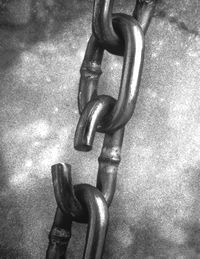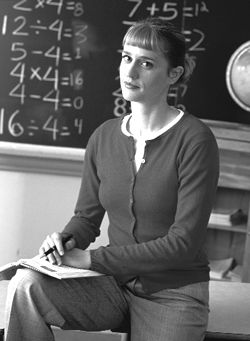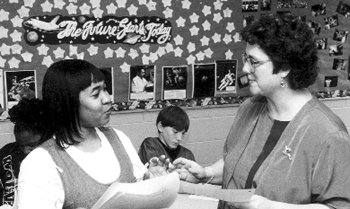
Picture Gerard, a 28-year-old business consultant who majored in economics at Williams College and graduated with a 3.7 GPA. Gerard has been working for a consulting firm in Stamford, Connecticut, but is looking for a new, more fulfilling position. He has demonstrated strong interpersonal skills and work habits. In addition, though he didn’t major in math, he aced several calculus courses in college. Yet if Gerard were to apply through normal channels to teach math at a junior high school in the Hartford public school system, his application wouldn’t even be considered. Why? Because he isn’t a certified teacher.
Why shouldn’t a principal or a faculty hiring committee in the Hartford schools even be allowed to look at Gerard’s application, to judge his qualifications against those of other candidates? The assumption undergirding the contemporary approach to teacher certification is that public school hiring personnel are either unable or unwilling to gauge the quality of applicants. Our response has been to embrace a bureaucratic solution that handcuffs the capable and incapable alike and supposedly keeps weak teachers out of the classroom. As a result, having discouraged or turned away Gerard and hundreds like him, many large school systems resort to last-minute fill-ins who teach on emergency certificates.
This is not to suggest, even for a moment, that candidates with “real world” experience or high GPAs are necessarily qualified or equipped to become teachers or that professional preparation for teachers is unimportant. It is only to say that some potential applicants might be more effective teachers than the alternatives that are currently available to public schools.
The central premise underlying teacher certification is that-no matter what their qualifications are-anyone who has not completed the specified training is unsuited to enter a classroom and must be prohibited from applying for a job. Presumably, the danger is that, in a moment of weakness, a school official otherwise will mistakenly hire such an applicant rather than an appropriately trained teacher. It is essential to remember what we often seem to forget, which is that allowing someone to apply for a job is not the same as guaranteeing him employment. Making applicants eligible for a position simply permits an employer to hire them in the event that they are deemed superior to the existing alternatives. The argument against certification is not that unconventional applicants will be good teachers; it is only that they might be. If one believes this, case-by-case judgments are clearly more appropriate than an inflexible bureaucratic rule.

Imagine if colleges and universities refused to hire anyone who lacked a Ph.D. They would lose the talents and insights of “lay practitioners” like poet Maya Angelou, journalist William Raspberry, or former public officials such as Alan Simpson, Julian Bond, and Al Gore. The artists and writers “in residence” at dozens of public universities would fail to meet the criteria implicit in the public school certification model. Do we really believe that these universities are ill-serving their students by hiring people whom the public schools would consider unqualified?
Competitive Certification
The theory behind certifying or licensing public school teachers is that this process elevates the profession by ensuring that aspiring teachers master a well-documented and broadly accepted body of knowledge and skills important to teaching. Supporters of teacher certification often make analogies to professions like law and medicine, where being an effective professional requires the acquisition of vast knowledge and skills. Licensure in these professions ensures at least minimal competency and boosts the public’s confidence in members of the profession.
The problem is that no comparable body of knowledge and skills exists in teaching. Debate rages over the merits of various pedagogical strategies, and even teacher educators and certification proponents have a hard time defining a clear set of concrete skills that makes for a good teacher. Yet most aspiring teachers are still forced to run a gauntlet of courses, requirements, and procedures created by accredited training programs that vary dramatically in quality.
This is not to deny that teacher education can provide valuable training. After all, one may think that journalism schools produce better journalists without requiring all journalists to complete a mandatory set of courses before seeking work in the profession. Instead, it is assumed that a candidate’s training is factored into the hiring process, along with considerations like aptitude, diligence, and energy.
Clearly some sort of screening process for aspiring teachers is essential; parents and the public rightly expect safeguards for those working with youngsters. What is needed is a competitive certification process that establishes key criteria for entry into the teaching profession; gives public schools greater freedom to hire and fire teachers; and treats teachers like professionals and their schools like professional institutions by allowing them to tailor professional development to meet the needs of teachers. Under such a model, aspiring teachers ought to be able to apply for a teaching job if they:
–Possess a B.A. or B.S. degree from a recognized college or university.
–Pass a test that demonstrates competency in knowledge or skills essential to what they seek to teach. The definition of “essential” knowledge or skills is obviously a loose one that can be interpreted in myriad ways and rightly should be different for those wishing to teach younger children or older students. The key point is to demand that teachers at least have an appropriate academic knowledge of the material they will be teaching.
–Pass a rigorous criminal background check. States conduct such checks now, but they tend to be compromised by the state’s need to engage simultaneously in related certification paperwork.
Beyond these minimal qualifications, the competitive approach presumes that preparation and training are not only desirable but also essential, as is true in other professions where subtle skills and interpersonal dynamics are essential to effective performance. The questions are where to obtain this training and who should pay for it. Contemporary teacher preparation imposes nearly all of the costs on candidates by forcing them into a system of training that removes key incentives for quality and relevance in teacher preparation. The competitive model instead treats teachers as autonomous professionals able to make informed decisions about developing their skills and expertise. In short, the competitive model would substitute meaningful professional development for what is essentially a guild system funded by levying a significant tuition-based tax on aspiring teachers before permitting them to enter the profession.

Photograph by Pierre Tremblay/Masterfile
The Assumptions of Certification
Over the years, an array of studies has sought to determine whether certified teachers serve students more effectively than uncertified teachers. There are two problems with this line of work. First, the methodological wrangling has often obscured the larger questions and the central assumptions of the certification model. Second, the case for certification is thin whether or not certified teachers boost student achievement more than their uncertified peers. The issue is not whether teacher education improves the performance of graduates, but whether we ought to-as best we are able-bar from teaching those who have not completed an approved preparatory program. Certification systems deny school administrators the ability to take their context or the promise of a particular applicant into account when hiring. Even if certified teachers are generally more effective than uncertified teachers, such a policy only makes sense if we believe that uncertified applicants are uniformly incompetent to teach or that school administrators cannot be trusted to assess their competence.
The allure of certification rests on three implicit assumptions. They are the beliefs that: 1) the training one receives while getting certified is so useful that the uncertified will be relatively ill-prepared; 2) certification weeds out unsuitable candidates; and 3) certification makes teaching more “professional” and therefore a more attractive career. However, each of these presumptions is problematic in the case of teacher certification.
As a general principle, certification is most effective when the licensing body ensures that aspiring professionals have mastered essential skills or knowledge and denies a license to inadequate performers. Licensure is most essential when a professional’s tasks are critical and when clients may have trouble assessing a provider’s qualifications. For instance, licensure is considered particularly appropriate for engineers, doctors, and attorneys because those who design bridges, tend us when we are ill, or defend our rights all perform tasks essential to our well-being and are frequently charged with aiding us at our most vulnerable. Moreover, it can be difficult for members of the public to know whether a bridge is properly designed, whether a doctor is performing appropriately, or whether an attorney is knowledgeable in the law. Licensing is not an assurance that these professionals are talented practitioners, but it does ensure that they have demonstrated an established degree of professional knowledge.
Educators are also charged with a crucial task. However, the oversight challenge is very different in education, where we have not established a specific, measurable body of skills or knowledge that teachers must master. Educational “experts” themselves argue that teaching is so complex that it can be difficult to judge a good teacher outside of a specific classroom context. This makes it difficult, if not impossible, to determine abstractly which aspirants possess satisfactory “teaching skills.” Meanwhile, there is widespread agreement that colleagues, supervisors, and families have at least a proximate ability to gauge whether a teacher is effective. Given these circumstances, it is unclear how standardized licensing helps to safeguard teacher quality.
Such a conclusion does not require refuting the claims of teacher educators or the supporters of certification. It actually follows if one simply accepts their claims. Professional educators themselves have thus far been unable to explain in any concrete sense what makes a teacher competent or what teachers need to know and be able to do.
Consider the widely praised standards that the National Board for Professional Teaching Standards (NBPTS) has painstakingly constructed in 27 distinct fields, standards that certification’s proponents have hailed as a breakthrough in quality control. The area where the NBPTS ought to have the easiest time creating straightforward standards is high-school math and science teaching, where there is widespread consensus as to what teachers are supposed to do. Even in these areas, however, the NBPTS’s “exemplary” standards are so broad and vague as to make concrete judgments of competence nearly impossible. For instance, to receive National Board certification to teach high-school math, teachers are to demonstrate mastery of 11 standards, including: commitment to students and their learning, the art of teaching, reflection and growth, and reasoning and thinking mathematically. The board tries to clarify these standards by explaining, for instance, that “commitment” is interpreted as meaning that “accomplished mathematics teachers value and acknowledge the individuality and worth of each student, believe that all students can learn,” and so on. Mastering the “art of teaching” is taken to mean that teachers “stimulate and facilitate student learning by using a wide range of formats and procedures.” While these are certainly admirable sentiments, nowhere in the National Board’s rarified standards is it clear how we are to gauge just what constitutes “competence” in these tasks. The result, unsurprisingly, is that the board has been assailed for the capricious way in which the standards are being interpreted and applied. Despite the best of intentions in the drafting of the INTASC standards, which Mary Diez discusses, a cursory read makes clear that they are plagued by the same ambiguities evident in the NBPTS standards.
For another prominent example, consider education professors Gerald Grant and Christine E. Murray’s award-winning 1999 Harvard University Press book, Teaching in America. They identify five “essential [teaching] acts” that can be analyzed and taught: listening with care; motivating the student; modeling caring by hearing and responding to the pain of others, and by creating a sense of security in their classrooms; evaluating by clarifying, coaching, advising, and deciding on an appropriate challenge for this boy or that girl; and reflecting and renewing. How one is to teach these five “essential acts,” much less determine whether a teacher has satisfactorily mastered them, are questions that Grant and Murray never address.
If clear standards of professional competence do not exist, we typically (and appropriately) hesitate to prohibit some individuals from practicing a profession. This is not to say that we think incompetence is acceptable in such a profession-only that we recognize licensing as an ineffective and potentially pernicious way to control quality. While licensure could protect community members (including children) from exposure to “bad” entrepreneurs or journalists, we do not prohibit some people from seeking to start businesses or work for a newspaper. Instead, we trust that potential investors or employers are the best judges of who ought to be supported or hired. If an aspiring writer or entrepreneur is unsuccessful, we trust that they will eventually be persuaded to find a line of work for which they are better suited. This free-flowing process fosters diversity and ensures that unconventional workers are given a chance to succeed.
Even in professions with clear knowledge- or performance-based benchmarks for certification, as in law or medicine, licensure is useful primarily as a way of establishing minimal competence. A medical or a law license is not imagined to ensure competence in ambiguous, subtle skills like comforting a patient or swaying a jury-skills analogous to the interpersonal relations thought crucial to teaching. Basing certification on such traits is difficult, because we may disagree about what they entail or how they can be assessed devoid of context. The skills that teacher educators deem most important-listening, caring, motivating-are not susceptible to standardized quality control. Emphasis on these qualities is the norm in professions like marketing, journalism, consulting, or policymaking, where a subtle blend of people skills, knowledge, and relevant expertise is required. In professions like these, where there are a number of ways for practitioners to excel but where it is difficult to know in advance how any particular practitioner will perform, the most sensible way to find talent is to allow aspirants to seek work and to permit employers to screen on a variety of criteria-such as education, experience, and references.

A Dubious Screen
While certification can serve to screen out aspirants who fail to meet a minimal performance standard, our current system is not designed to do so. Generally speaking, schools of education are not selective, flunk out few if any students for inadequate performance, and see that many of their teacher education graduates receive teacher licenses. The licensing exams are simple, and standards for passage are generally so low that the Education Trust concluded they exclude only the “weakest of the weak” from classrooms.
More than 1,300 institutions provide the training required for licensure. While defenders of the current approach to certification often focus on the certification programs at elite institutions, the top 25 education schools train less than 5 percent of the roughly 200,000 new graduates that teacher programs produce each year. It is the regional colleges, such as Illinois State University, Cal State-Hayward, and Southwest Texas State University-not the Stanfords and the Ohio States-that train and license the vast majority of teachers. The value of certification turns not on the quality of elite programs but on that of regional colleges.
Teacher-preparation programs neither screen out nor weed out weak candidates. Even at elite schools, such as UCLA or the University of North Carolina, where admissions rates are about 5 percent for medical school and 25 percent for law school, the M.Ed. programs (which include those seeking postgraduate training for teacher certification) accept more than half of their applicants. Moreover, education-school officials often make it clear that they do not see their mission as weeding out students during their course of study. Notes one such official, “We’re here to develop teachers, not to screen people out. For the most part, everyone who enters the program is going to complete it, unless they decide that teaching’s not for them.”
The Costs of Certification
Especially for anyone who didn’t complete a teacher-training program as an undergraduate, the costs of certification can be significant. It is not unusual for postgraduate teacher training programs to require a full-time commitment of 16 or even 24 months or a part-time commitment that can stretch to three years or more. The cost of training and the loss of salary due to time spent out of the workforce can easily reduce a teacher’s real compensation during her first five years by 25 percent or more.
These barriers make other professions relatively more attractive, so that potentially talented teachers who are unsure about their interest are less likely to try teaching. Whereas candidates can readily try journalism or consulting or marketing for a year, they must make an extensive commitment before they can try public school teaching. The result is that many who might make fine teachers never enter the profession. There is disturbing evidence that certification may especially dissuade accomplished minority candidates-who have a number of attractive career options and who are often less well situated to absorb the costs of teacher preparation-from entering teaching.
This would pose no real problem if we were blessed with a surplus of good teachers. In such a case, we might scoff “good riddance” to those dissuaded from teaching. However, we have a desperate need for competent teachers. Moreover, rather than a lack of commitment to teaching, a reluctance to pursue certification may indicate that individuals have attractive alternatives. It is the most talented and hardest working individuals who have the most career options and who sacrifice the most by entering a profession where compensation is unlinked to performance and where opportunities for advancement are few. They may wish to teach but be unwilling to forgo work for a year, sit through poorly regarded courses, or jump through procedural hurdles. It is candidates with fewer attractive options who will find the tedious but intellectually undemanding requirements of certification less problematic. In fact, by suppressing the supply of teachers, certification provides teachers with enhanced job security. Coupled with a compensation scale that rewards seniority rather than performance, certification may well make the profession more attractive to graduates seeking a less demanding line of work. In this way, certification can actually harm the public’s perception of teaching as a profession-the very opposite of what certification proponents wish to do.
Creative Destruction
In a world without certification as we know it, districts and schools would have more flexibility to ensure that their new teachers are prepared, inducted, and supervised in a manner appropriate to the challenges at hand. Because aspiring teachers would no longer have to attend formal teacher-preparation programs in order to teach, they would be free to make professional decisions about training in the same manner as business school or journalism school students. Weaker teacher-preparation programs would likely fall by the wayside. The fact that schools of education could no longer rely on a captive body of aspiring teachers would expose them to the cleansing winds of competition. Schools would have to contribute value-by providing teacher training, services, or research that created demand and attracted support-or face significant cutbacks. Teacher-preparation programs would find it in their own self-interest to ensure that their graduates were knowledgeable and skilled, as this would help graduates to win desirable jobs amid increased competition, making preparatory institutions more attractive.
Under a competitive certification system, little is likely to change in many of our high-performing suburban districts, where officials are inundated with applicants and are unlikely to tamper with a formula that is “working.” In such districts, except in rare cases, we would expect that administrators would continue to cherry-pick from the nation’s top teacher-education graduates. It is in the less desirable and more troubled systems, the nation’s urban and rural school districts, that administrators currently have tremendous difficulty finding sufficient numbers of certified teachers. This is doubly true in the areas of math and science education. It is in these districts and subjects, where critics have fretted about the numbers of long-term substitutes and “burned out” veterans, where the wave of new teachers will most likely be recruited and welcomed. While many of the resultant applicants will no doubt be deemed unprepared or unsuited for the jobs they pursue, there are few urban or rural principals who would not welcome the chance to pick and choose from their ranks.
Critics may fear that the elimination of licensure requirements will mean the end of teacher preparation and professional development. Such concern is unfounded. First, allowing uncertified individuals to become teachers does not mean that they must be viewed as “completed” professionals. Such a mindset is one of the vestiges of our current system, which is erected on a premise that all teachers are certified and therefore competent. Here, a better model might be medicine or law, where entering professionals begin their career with a trial period (serving as a hospital resident or as a junior partner in a law firm, for instance) during which their full panoply of skills is developed and monitored. Beginning teachers might serve on a probationary basis, receiving substantial monitoring and counseling. However, legal and contractual language ought to make it much simpler to terminate ineffective teachers or to mandate that they engage in support activities designed to improve their performance.
Second, moving to competitive certification does not mean doing away with professional teacher-education programs. Many applicants attend journalism school or business school, even though such training is not officially required, because it may make graduates more effective and can help them find better employment more readily. Likewise, aspiring teachers would presumably continue to attend those teacher-training programs thought to enhance their employability. This change would introduce some much-needed market pressure in this area, as schools would be forced to compete for students based on the usefulness of their course offerings.
Giving districts more leeway to hire promising candidates does not mean they will always make good decisions. Some ineffective teachers will inevitably continue to be hired. However, if entry to the profession is eased, it is appropriate that exit be eased as well. If administrators are to have more leeway to make hiring decisions, they also must be given more leeway to fire-and they must be held accountable for both sets of decisions.
At the end of the day, the individuals best equipped to assess the qualifications of prospective teachers are the principals who will be responsible for them. These same principals ought to have the strongest incentive to see that teachers are effective. If we believe that the administrators charged with managing and supervising schools either are unequipped to evaluate prospective teachers or are unwilling to do so, teacher certification will not suffice to protect our children from such profound systemic dysfunction. If we trust administrators, then certification is unnecessary and entails significant costs. If we don’t trust administrators, let us address that issue directly and not rely on the hollow promise of flimsy parchment barriers. Regardless, it is past time to fully acknowledge the nuanced, multifaceted, and professional nature of teaching and to move beyond a system that restricts professional entry with procedural barriers characterized by ambiguity that are the result of an inability to clearly define the skills, knowledge, or training essential to good teaching.
-Frederick M. Hess is an assistant professor of education and government at the University of Virginia and directs the Virginia Center for Educational Policy Studies.


